Glass pot gardens are an attractive, hassle-free way to cultivate many of your favorite plants, whether you have a limited outdoor gardening area or want an attractive inside garden.
Although plants grown in containers often require slightly more care than plants planted in the ground, the best thing about planting in pots is that we don’t have to be concerned about their making it through the winter.
This article will discuss the best tips and tricks for growing plants in glass pots. We will also let you know the plants you can grow quickly in glass containers or bottles.
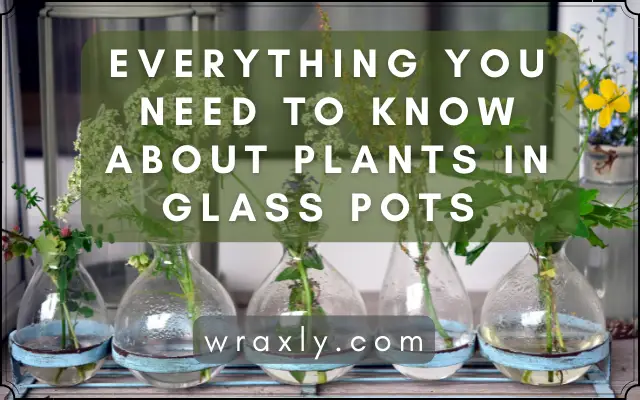
Can You Grow Plants in a Glass Pot?
Yes, you can grow plants in a glass container.
Glass pot plants are an excellent option for those who love plants and interior design and are constantly searching for new methods to showcase their treasured houseplants.
You may use old-fashioned mason jars and professionally made glass pots to grow plants; however, there are certain restrictions on the kinds of plants you can grow.
It would be best if you also took particular safety measures to guarantee the continued health of your plants. When planted with vibrant foliage and contrasting textures, bottle gardens make fantastic indoor focus areas.
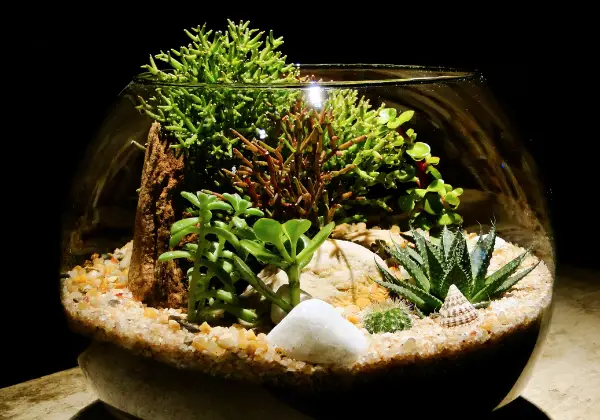
How To Grow Plants in a Glass Container?
Growing a plant inside a glass pot sounds practical, inventive, and simple. The versatility of glass containers is another attractive feature; all you need to do is match the glass container to the right plant.
There are three simple and easy ways to grow a plant in glass pots or vessels:
- You can use glass containers for traditional potting, which requires soil or a passive hydroponics system to grow plants.
- Glass terrariums are the second and most popular method of growing a plant inside a glass pot.
- Another option is glass jars filled with root cuttings. It forms an eye-catching exhibit.
Things To Consider Before Growing Plants in Glass Pots
Though there are numerous aspects you must look at when growing plants in a glass pot, here are the essential points you shouldn’t miss:
- Choosing a suitable plant is the primary consideration for glass pots.
- Plants that enjoy dampness grow best in closed containers like glass bottles and pots. You may integrate plants that favor drier conditions in open glass containers.
- There are no drainage holes in glass pots, and you can’t drill a hole. So, ensure the glass pot’s bottom has good drainage unless you’re rooting cuttings. Add a suitable thick layer of drainage material like clay pebbles or coarse gravel.
- If you grow plants in water, you should regularly replace the water and avoid exposing them to excessive light. The plant could suffer from algae and too much wetness.
- Lighting requirements varies according to the needs of the selected plants. Too much light can encourage the growth of algae, resulting in a green film inside the glass pot. Additionally, direct sunshine may heat the glass pot and harm the root system.
- You don’t have to worry about the watering and drainage system if you plant root cuttings inside the glass pot to grow. However, you must take care of lighting and other maintenance-related considerations.
- Finally, if you want your aquatic plant to flourish for a long time, you must keep an eye on the mineral and nutrient levels.
11 Plants You Can Grow in Glass Pots
Numerous plants can flourish in glass containers. Here are the ten best plants to grow in glass pots.
1. Herbs
You can quickly grow various herb species in glass bottles or pots. Planting herbs indoors in glass pots is simple, affordable, and practical.
Some examples that will work well include basil, mint, dill, rosemary, parsley, oregano, thyme, watercress, and chives.
Gently separate roots to promote growth, and then tightly pack the mixture around the plant’s roots and base. Growing herbs in containers are easy when done right.
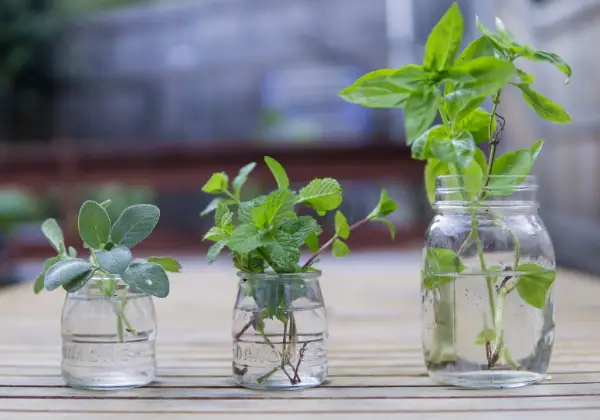
2. Pothos
There are two ways of growing pothos in glass pots; you can put them in a soil-containing pot or just inside the water-filled pot.
The pothos will be ready to bloom once you’ve successfully planted them in the bottle or jar of your choice, either in soil or water.
However, water pothos is preferable because of its low requirements and maintenance.
3. Wandering Jew
You may also plant Wandering Jew, as it has many attractive variants. You have a wide range of options, including Tradescantia blossfeldiana and tradescantia fluminensis.
Species of tradescantia are pretty versatile, and you can cultivate in soil, water, or a mixture of both.
They are delicate and multicolored and seem attractive if you plant them inside glass pots. It gives you a stunning display for your indoors and balcony.
4. English Ivy
You can also try planting ivy plants. These plants thrive in containers filled with soil or water.
Ensure they receive enough sunlight to prevent any issues. These are also beautiful additions to elevated perches like bookshelves or balconies.
5. Cactus
Like Bishop’s Cap and Angel’s Wings, you can also plant cacti species in glass containers. You don’t need to water these plants frequently because they have evolved to live in harsh desert environments.
Don’t overwater them; ensure to keep them in direct sunlight most of the day. They make a terrific addition to your indoors, including your bedroom, living room, and kitchen.
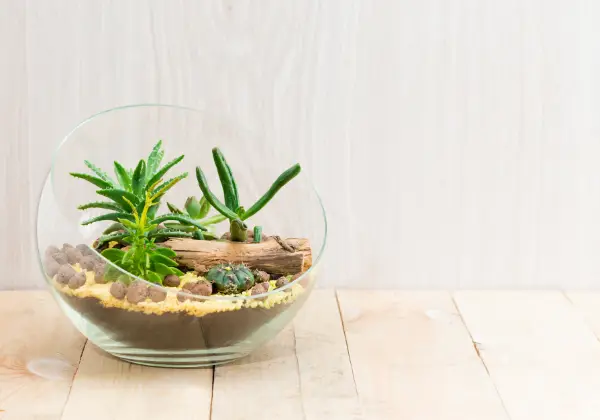
6. Aloe Vera
You’re mistaken if you think you can only use plants in glass containers for aesthetic reasons. For instance, aloe vera is an excellent plant to grow inside glass pots quickly.
We are all aware of its numerous health and nutritional advantages. However, if it begins to outgrow the pot, you must transfer it to a larger pot for proper growth and care.
7. Watch Chain Plant
This crassula species appears magical when enclosed in a glass container. Though it requires high maintenance, you can cultivate crassulas that require less care.
It is recommended to water carefully to avoid overwatering plants in jars with no drainage. When it grows, it’ll provide a positive and refreshing environment in the house.
8. Wheatgrass
Wheatgrass can flourish in a mason jar filled with nutrient-rich soil. Growing wheatgrass is simple, and a glass jar makes the ideal planter.
All you need to do is sow some wheatgrass seeds and water them as needed. Additionally, ensure to keep the soil moist and place the container out of direct sunlight so the the soft leaves can grow.
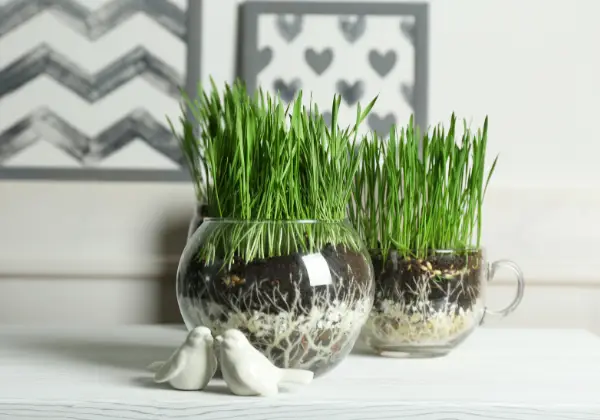
9. House Holly Fern
House Holly Fern is a low-maintenance plant with glossy green leaflets that look great with other vibrant houseplants. It grows best in well-draining soil with indirect sunshine.
You can grow it indoors or outdoors in glass containers. Although it can’t withstand frigid temperatures, holly fern may easily survive somewhat severe winters.
10. Succulents
Succulents are tiny, adorable plants that come in various sizes and colors. You can choose them based on the size of the jar. As long as there is adequate natural light, these are perfect for home display.
You may add natural color to your yard or inside settings by planting colorful varieties like chalk sticks, California sunset, Coppertone Stonecrop, Red Aloe, and Sunset Jade.
Further, read these succulents growing tips if you want to make your succulents grow big.
Recommended Glass Terrariums
| Image | Title | Prime | Buy |
|---|---|---|---|
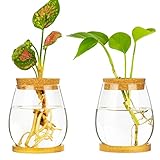 | Plants Propagation Station Terrarium Glass Planter Vase Clear Plant Cuttings Holder with Wooden Lid and Bamboo Stand for Growing Hydroponic Plants Home Office Desktop Decoration | PrimeEligible | Check My Price on Amazon |
Top | Yangbaga Large Glass Terrarium Succulent Plant Terrarium House for Plant/Moss Ball /Glass Fish Tank Mini Table with Wood Base & Ball lid Office Home Decoration | PrimeEligible | Check My Price on Amazon |
 | Syndicate Sales 1/2 Gallon Footed Terrarium w/Lid, Clear | PrimeEligible | Check My Price on Amazon |
 | Cape Craftsmen Hand-Blown Blue Tinted Bubble Glass On Driftwood Terrarium Décor Planter (Small) | PrimeEligible | Check My Price on Amazon |
 | Mini Glass Geometric Terrarium Container,Set of 4,Gold Terrarium Set,Glass Flower Pot Planter Vase Bowl Indoor Succulent Fern Moss Air Plants,Display Box Decor Table Window Sill Balcony (NO Plants) | PrimeEligible | Check My Price on Amazon |
 | Cute Farms Terrarium Starter Kit | Moss, Vermiculite, Soil, Pebbles, Plant Food, Finishing Tools, Build and Care Guide | DIY Succulent Terrarium Kit for Adults and Kids (Large Kit) | PrimeEligible | Check My Price on Amazon |
 | Glass Irregular Geometric Terrarium Large Tabletop Black Moss Container for Fern Succulents Opened Indoor Glass Planter Decor Handmade 9.8'' Height No Door | PrimeEligible | Check My Price on Amazon |
 | Ivolador Set of 2PCS 4.7 Inches Hanging Plants Glass Terrarium Container Air Plant Holder Succulents Globe Shape Home Garden Décor | PrimeEligible | Check My Price on Amazon |
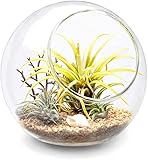 | Mkono Plant Terrarium Display Glass Tabletop Succulent Air Plant Planter Globe Microlandschaft House, M | PrimeEligible | Check My Price on Amazon |
11. Snake Plant
Another great choice, especially for indoor areas, is the snake plant. The contrast of its vibrant green and yellow leaves would appear spectacular in a glass pot.
It not only produces large amounts of oxygen, but it also serves as a natural air filter. That means it will help purify the air in your environment.
Final Thoughts on Plants in Glass Pots
After reading this article, we hope you have a better understanding of the potential of plants in glass pots.
Maintaining plants in glass containers is simple by providing sufficient drainage, watering, lighting, and safety measures.
Glass plant pots are an excellent option for indoor and outdoor plants.
They can be visually appealing by planting vines or flowers, or practical by growing cooking herbs.
You can pick any of the plants mentioned above and easily start a modest glass container plant collection.
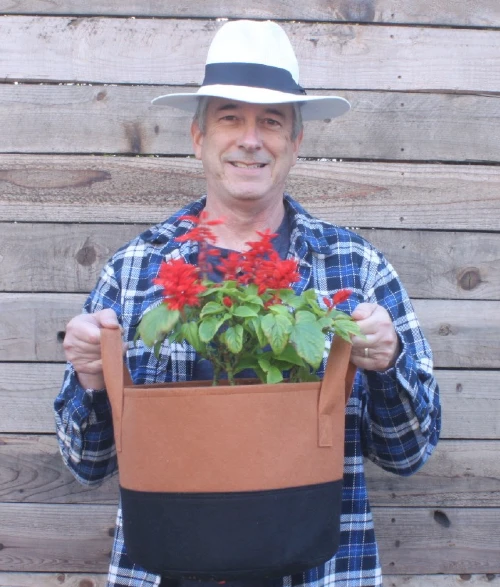
Darrell has a passion for gardening that he inherited from his father. Go here to read more about the influence his father played in his love for gardening. If you want to send Darrell a quick message, then visit his contact page here.
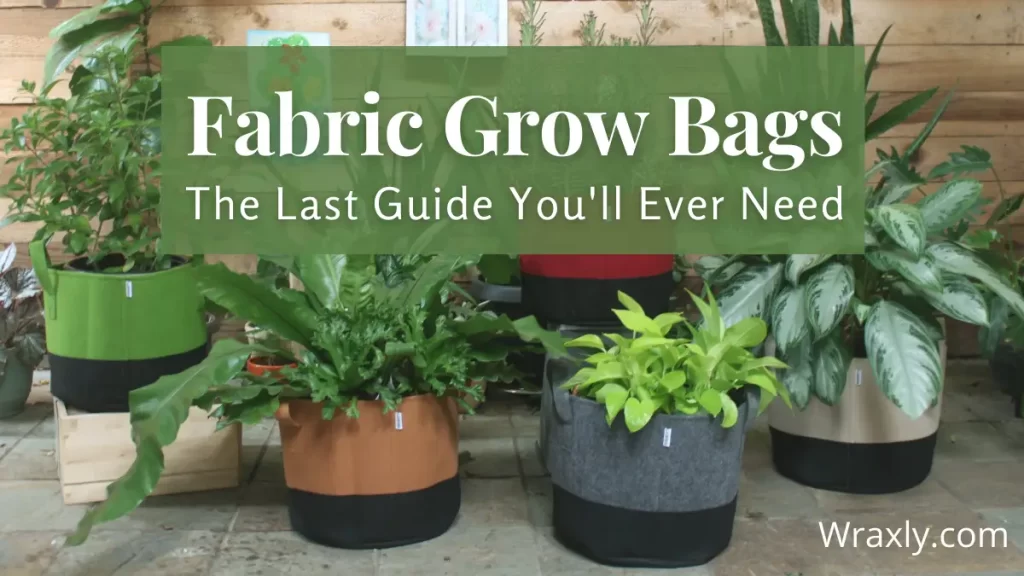
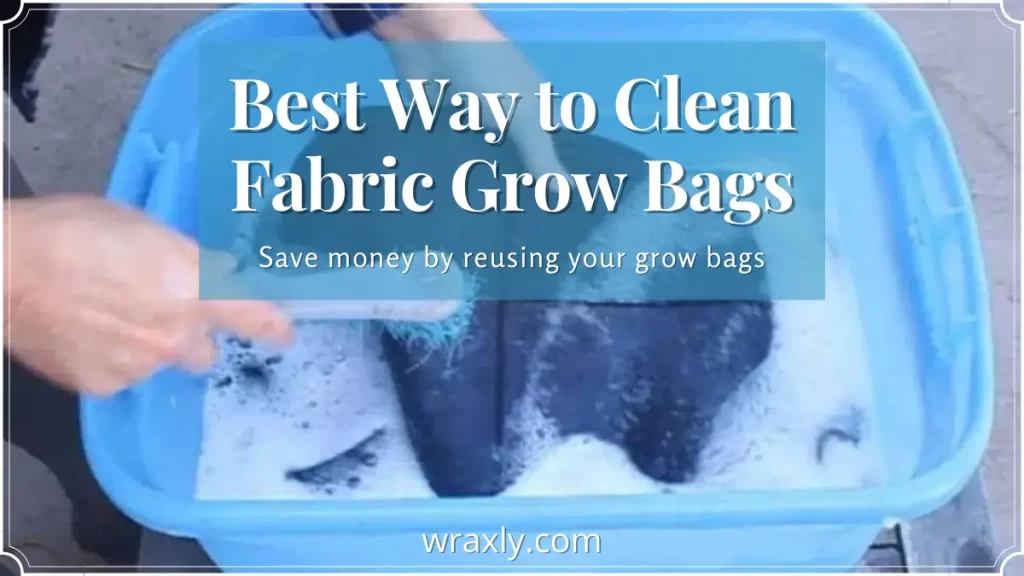
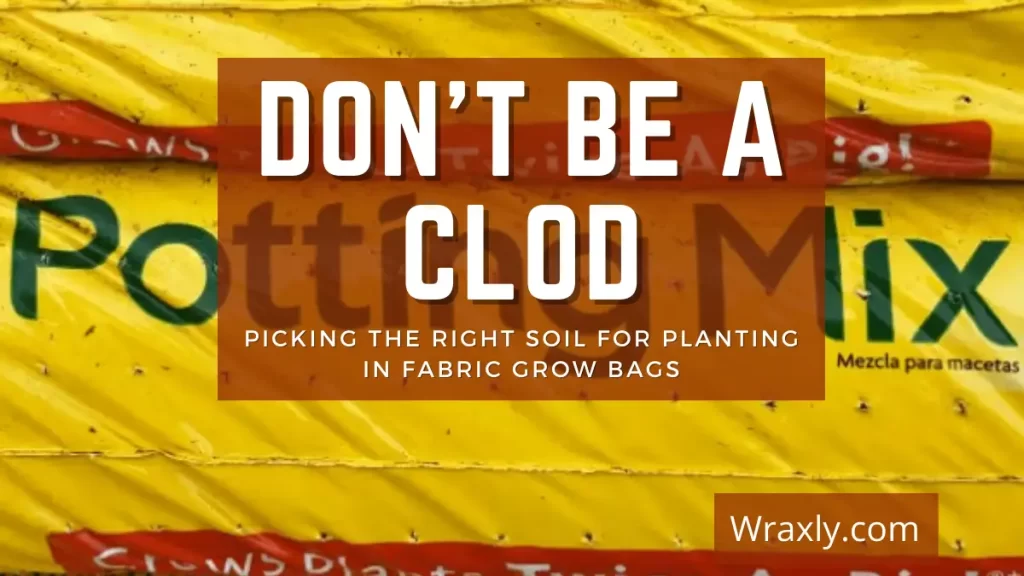
![Container gardening for beginners [Buying guide]](https://wraxly.com/wp-content/uploads/2021/02/Container-gardening-for-beginners-Buying-guide-1200-1024x576.webp)